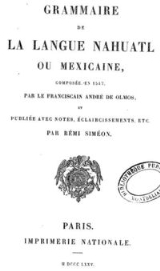
Arte para aprender la lengua mexicana
Encyclopedia
The Arte para aprender la lengua mexicana is a grammar
of the Nahuatl language in Spanish
by Andrés de Olmos
. It was written in Mexico
in 1547, but remained in manuscript
form until 1875, when it was published in Paris
by Rémi Siméon under the title Grammaire de la langue nahuatl ou mexicaine. Olmos' Arte is the earliest known Nahuatl grammar.
As with usual Nahuatl orthography
, Olmos did not write glottal stop
s (saltillos
), or distinguish vowel length
. He was, however, almost unique in distinguishing the voiced and voiceless allophone
s of /l/, writing [ɬ] as lh.
Grammar
In linguistics, grammar is the set of structural rules that govern the composition of clauses, phrases, and words in any given natural language. The term refers also to the study of such rules, and this field includes morphology, syntax, and phonology, often complemented by phonetics, semantics,...
of the Nahuatl language in Spanish
Spanish language
Spanish , also known as Castilian , is a Romance language in the Ibero-Romance group that evolved from several languages and dialects in central-northern Iberia around the 9th century and gradually spread with the expansion of the Kingdom of Castile into central and southern Iberia during the...
by Andrés de Olmos
Andrés de Olmos
Andrés de Olmos , Franciscan priest and extraordinary grammarian and ethno-historian of Mexico's Indians, was born in Oña, Burgos, Spain, and died in Tampico in New Spain...
. It was written in Mexico
Mexico
The United Mexican States , commonly known as Mexico , is a federal constitutional republic in North America. It is bordered on the north by the United States; on the south and west by the Pacific Ocean; on the southeast by Guatemala, Belize, and the Caribbean Sea; and on the east by the Gulf of...
in 1547, but remained in manuscript
Manuscript
A manuscript or handwrite is written information that has been manually created by someone or some people, such as a hand-written letter, as opposed to being printed or reproduced some other way...
form until 1875, when it was published in Paris
Paris
Paris is the capital and largest city in France, situated on the river Seine, in northern France, at the heart of the Île-de-France region...
by Rémi Siméon under the title Grammaire de la langue nahuatl ou mexicaine. Olmos' Arte is the earliest known Nahuatl grammar.
As with usual Nahuatl orthography
Nahuatl transcription
Nahuatl orthography describes the methodologies and conventions used to express the Nahuatl languages and dialects in some given writing system, and the inventory of glyphs, graphemes and diacritics employed for that purpose....
, Olmos did not write glottal stop
Glottal stop
The glottal stop, or more fully, the voiceless glottal plosive, is a type of consonantal sound used in many spoken languages. In English, the feature is represented, for example, by the hyphen in uh-oh! and by the apostrophe or [[ʻokina]] in Hawaii among those using a preservative pronunciation of...
s (saltillos
Saltillo (linguistics)
In Mexican linguistics, saltillo refers to a glottal stop consonant, . It was given that name by the early grammarians of Classical Nahuatl. In a number of other Nahuatl languages, the sound cognate to Classical Nahuatl’s glottal stop is , and the term saltillo is applied to either pronunciation...
), or distinguish vowel length
Vowel length
In linguistics, vowel length is the perceived duration of a vowel sound. Often the chroneme, or the "longness", acts like a consonant, and may etymologically be one, such as in Australian English. While not distinctive in most dialects of English, vowel length is an important phonemic factor in...
. He was, however, almost unique in distinguishing the voiced and voiceless allophone
Allophone
In phonology, an allophone is one of a set of multiple possible spoken sounds used to pronounce a single phoneme. For example, and are allophones for the phoneme in the English language...
s of /l/, writing [ɬ] as lh.

